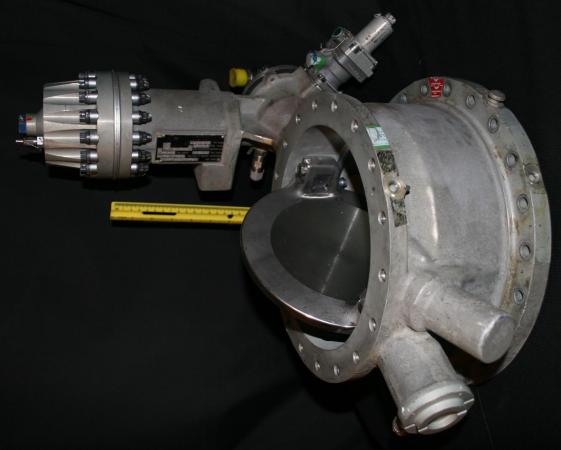Artifact: Pre-Valve Assembly, Liquid Hydrogen/Liquid Oxygen Propellant, J-2 Rocket Engine, Saturn V Second Stage (S-II)
Steel, Stainless Steel
A Saturn V Second Stage (S-II) Liquid Oxygen (LOX) and Liquid Hydrogen (LH2) Pre-Valve manufactured by North American Aviation (NAA) Space and Information Systems Division in 1968 under NASA Contract NAS 7-200 (primary contract awarded to North American Rockwell for design/build of the Saturn V Second Stage) . The Pre-Valve was a critical component of the S-II Propellant Delivery System and regulated the flow of propellants through separate feedlines to each of the Rocketdyne J2 engines.
The 8 inch prevalves were normally open, pneumatically actuated, electrically controlled, butterfly-gate type valves. Supported propellant flow rates were 386 pounds of LOX per second at 132 psi; and 78 pounds of LH2 at 132 psi. A built-in four-way pneumatic control solenoid permitted 750 +/- 50 psig helium pressure to actuate the butterfly-gate (response time was 1000 milliseconds). Should a loss of pneumatic or electrical power occur, the prevalves were designed to be spring actuated to return to the open position. During ground operations, the Pre-Valve was opened to permit propellant fueling and in conjunction with the recirculation subsystem, allow the propellant to cycle through the feed lines and valves servicing the J2 engines, maintaining uniform cryogenic density and temperature, and precluding the formation of gas in propellant plumbing. Following propellant tank loading and all the way up to the point of S-IC (Saturn V first stage) separation, the Pre-Valves were commanded to remain shut and were opened in conjunction with second stage ignition. They would normally remain open during S-II powered flight unless a signal was received from the engine shutdown system. The valves also provided a redundant shutoff of propellant concurrent with main valve closure.

